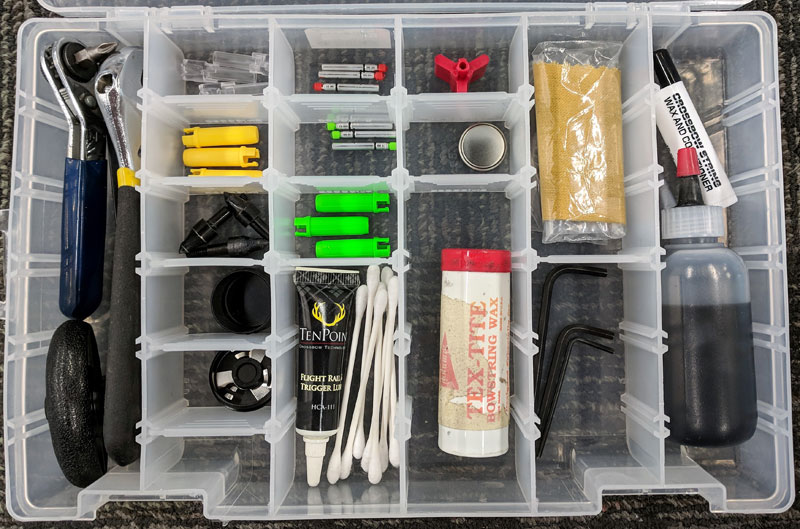Over the years, I have assembled a crossbow shooting kit that goes with me wherever I take my crossbow. I have had a need for every one of the items on this list, at one time or another, whether I was hunting with my crossbow or just doing some weekend target shooting at camp. Whether you are putting together a new shooting kit of your own, or checking your old toolbox to see what needs to be replenished, I hope that you find this list helpful.
GET YOUR CROSSBOW READY FOR HUNTING SEASON

Nocks: Always a good idea to have a few spare nocks in case you lose or damage one while shooting.
Nock Indexing Tool: This is needed to replace your nock if your nock requires a special tool for indexing while mounting. The crossbow arrows I shoot have Omni-Nocks, so I carry a special nock alignment tool to mount them.
Insert/Vane Glue: You never know when you might have an insert or vane come loose that can be easily glued back in place to allow you to continue shooting the arrow. Also, I use the glue to affix the Omni-Nock in my own arrows, since they were designed as a glue-in system.
Inserts: Just like spare nocks, you never know when you might lose one.
Spare Batteries or Light Sticks: If you use a lighted nock that has batteries or light sticks that are disposable, you should definitely have some replacements with you. You never know when a light may be triggered inadvertently, or a battery may fail, and you don’t want to be stuck with dead batteries and a nock that you cannot see while the arrow is in flight.
SHOOT-TUNE YOUR CROSSBOW FOR DEADLY ACCURACY
Field Points: You never know when you might need to shoot an arrow with a field point to test the sight of your crossbow.
Rust Protective Oil: I use this for protective maintenance on all parts of my crossbow that are susceptible to rust like bolt heads or trigger mechanism parts. Cotton swabs are great for applying oil to bolt heads and other rust-susceptible parts.
Cotton Swabs (Q-tips): I also use swabs to evenly apply flight rail lubricant, which can be very messy if you get it on your fingers.
Cotton Balls: I rub a cotton ball over the corners and surfaces of my limbs periodically to check for cracks or splinters. I’ve also used them to wipe dust and grit from the cams, flight rail, scope tube and trigger box.
String Wax: I check the string and cables for dryness every time I take my crossbow out to shoot. Shooting in the elements and in different temperatures can cause the string and cables to dry out at slower and faster rates.
Lens Cleaning Cloth: I use multiple types of optics when I am hunting – a rangefinder, binoculars and a scope. Since I hunt in dusty and wet conditions, I am often cleaning the lenses on my optics. If you do not use a proper lens cleaning cloth, you can permanently damage the surfaces of the lenses and reduce visibility through the optic.
Lens Pen: In addition to the cleaning cloth, I like to also carry a Lens Pen in my pack for easy use in the field.
Anti-Fog Glass Cleaner: I use this to prevent external fogging of the lenses of my optics – especially on the crossbow scope.
Small Brush/Toothbrush: I use this to remove debris inside the flight rail and inside the trigger box that can collect after traveling through the woods to my stand and back.
Toothpicks: These are great for getting small bits of debris out of tight spots that a brush cannot reach.
ROCK-SOLID ADVICE FOR STABLE CROSSBOW, COMPOUND SHOOTING
Metal Pick: I have one that looks like what the dentist uses to clean my teeth. It’s great for getting something out of a tight spot that the toothpick cannot.
Allen Wrenches: It’s best to buy a set of both SAE and Metric, as the bolts on your crossbow may be a mixture of both. While you are at it, you might want to buy a set of Torx head wrenches, as they are beginning to appear on many crossbows.
Screwdrivers: My crossbow has screws that require both flat-head and Phillips screwdrivers.
Spare Scope Battery: If you have ever forgotten to turn the battery on your scope off at night after coming in from hunting, you can easily understand the need for a spare.
Cocking Mechanism Parts: There are several parts that can wear out and require replacement for your cocking mechanism to continue to function safely – like cords, hooks, handles and springs. Getting caught without a replacement part might mean that you will not be able to cock the crossbow at all, which will ruin a hunt pretty quickly.
Spare Broadhead Parts: Broadheads can be damaged when target shooting or during field use. I keep spare blades, collars and O-rings in the toolbox so that I can repair the broadhead and continue to use it in the field, provided that the ferrule and tip are not bent.
— PAID PARTNER CONTENT. This content is brought to you by a D&DH advertising sponsor.
